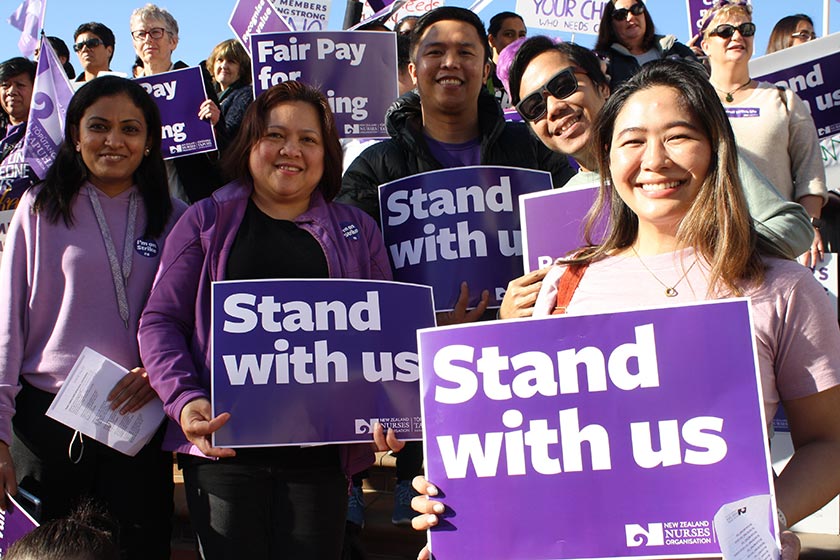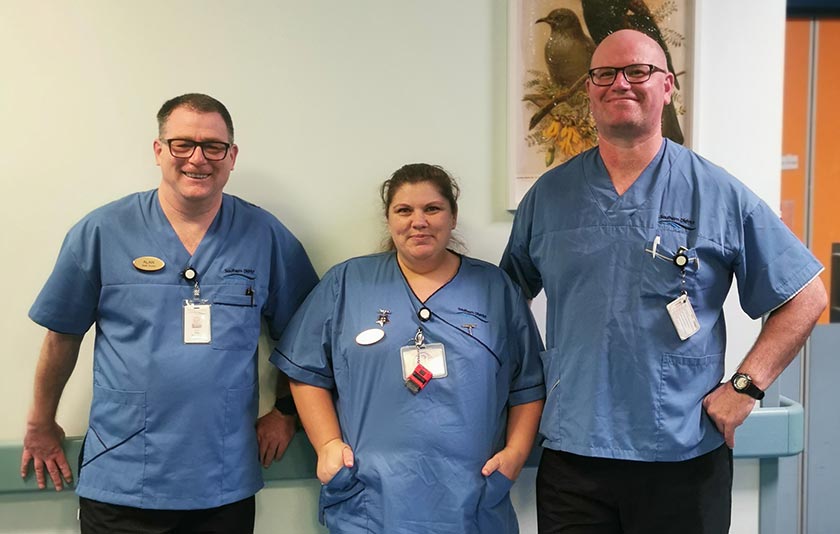
When thousands of nurses walked out of hospitals at 11am on June 9 to march for better pay and conditions, hundreds stayed behind. Not because they were strike-breakers – in fact, without them, the strike could not have gone ahead. And in Canterbury, it nearly didn’t.
It was only after a long Queen’s Birthday weekend of frantic ringing around, that agreed life-preserving services (LPS) staffing levels were met and late legal action threatened by the Canterbury District Health Board (DHB) was called off – demonstrating how crucial LPS workers are.
Wairarapa registered nurse (RN) and delegate Tania Corlett-Galyer reluctantly did LPS as she couldn’t find any volunteers so had to lead by example.
“I did not want to do it, I wanted to be out striking,” said Corlett-Galyer, who also took on the role in 2018. “But without LPS there is always the risk that we cannot strike.”
Colleagues did then step up to support her, so they had enough LPS to cover their 38-bed medical/surgical ward at Wairarapa Hospital.
Corlett-Galyer was able to escort staff out at 11am then spend a few hours on the picket lines, before her 3pm shift, but “struggled when I walked in, as my colleagues were still out there striking”.
The shift turned out “pretty damn busy” with a full ward, including some very sick patients.
Unlike 2018, Corlett-Galyer said this time nurses were “pretty strict” about their tasks, only doing what they considered essential. “We only did obs and life-preserving medications,” Corlett-Galyer said. This caused tension at times, such as when doctors asked them to provide pain relief.
“I had to put my foot down and say ‘no, you are not aware of what LPS we have agreed on… you do not get to tell my team what to do’.”
That was the most difficult part of the evening, she said.
It wasn’t easy for nurses to provide limited care to patients, knowing they were putting colleagues under pressure, but Corlett-Galyer felt it was important to stick to the LPS guidelines this time around.
“The last MECA was much different. It was a joke really and this time we were determined and stuck to what we were supposed to be doing,” she said. “As nurses, we don’t want to see harm come to our patients at all, but we had to get a bit firm this time around.”
The support of their unionised nurse managers and leaders helped – they ensured all the patients got what they needed. At the end of their shift, there was an emotional debrief.
“We thanked them [nurse managers] and said we couldn’t have gone on strike without their support.”

Corlett-Galyer said nurses were more determined to be heard this time. “Last time, nothing really changed in terms of safety,” she said. “It’s not just nurses we are standing up for, it’s our patients too. It’s unsafe for us and it’s unsafe for them.”
Her ward was shedding four to five nurses every month, she said – to Australia, other nursing sectors or professions.
Wellington district nurse and delegate Annie McCabe also volunteered for LPS, after sensing a reluctance in her team.
“I thought, if the delegate, one of the most staunch, is willing to do it, it’d be a bit of a game-changer.”
Colleagues have since promised they will take their turn. “Next time, I have the feeling there will be volunteers.”
Covering for 11 nurses who would normally be on during the day, McCabe received calls about insulin and blood sugar levels, compression bandages and a blocked catheter. Most were able to be resolved by phone, with friends or neighbours or family, or deferred until after the strike ended at 7pm.
“There was an unwillingness to break the strike. We didn’t want to deal with things that were not causing harm or a threat to life.”
Greymouth Hospital (Te Nīkau) critical care nurse Sonya Neill agreed to provide LPS cover on her day off and is also donating her wages to the strike fund.
“A couple of the young ones asked [me to cover] – they were keen to strike,” said Neill, who at 60 says she’s “been there, done that”.
Christchurch enrolled nurse and delegate Debbie Handisides stepped up at the last minute to plug the LPS gaps. “I would have been out there picketing, but we had to get it over the line.”
With community volunteers on hand – retired nurses and clerical staff – helping out, she said the day went smoothly. Workers got to share the meal provided to volunteers, patients got all their medication, she said. “I would do it again.”

Southland RN and delegate Alan Thornton said “overwhelming anger” from members at the DHB’s “insulting” revised offer made it hard to convince them to do LPS. “They wanted to shout from the Southland hills in protest! When I commented that this would allow others to do this for them, they reluctantly signed up,” said Thornton, who also did LPS himself.
Auckland emergency nurse Mandy Chow said she and others on the LPS team were confused about what they could and couldn’t do on the day. Initially, they only helped with the most urgent cases. But “it was hard to say no” to colleagues, doctors and patients, Chow said.
Eventually, Chow and her team decided to do whatever needed to be done on the day. Most patients didn’t seem to be aware of the strike, or weren’t interested – and because there were extra doctors on duty, were seen quickly. “So for the public it was great,” but for the nurses it was frustrating that their stand appeared to have little effect, she said.
Chow hoped guidelines on what LPS workers should be doing would be clearer in any future strike action.
NZNO acting industrial services manager Glenda Alexander said NZNO was deliberately not prescriptive in telling LPS workers what tasks they should do, as that could put patients at risk.
NZNO guidelines, based on the Employment Relations Act (2000) code of good faith for the public health sector, broadly state LPS workers must provide care to preserve life and prevent permanent disability.1
NZNO acting manager, professional and nursing services, Kate Weston said on the day, nurses and midwives must use their critical thinking and professional judgement when caring for patients.
Being on strike did not mean nurses were no longer accountable to the Nursing Council for their practice. But DHBs, too, had an obligation to ensure patients could be cared for safely on the day by doing things such as reducing patient numbers where possible.
“It’s not the sole preserve of LPS staff to provide all the care on the day.”
See also Why we need you to work while colleagues strike



